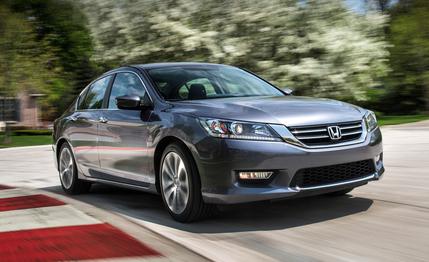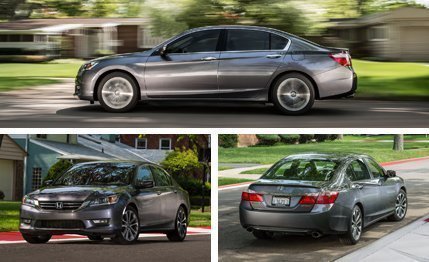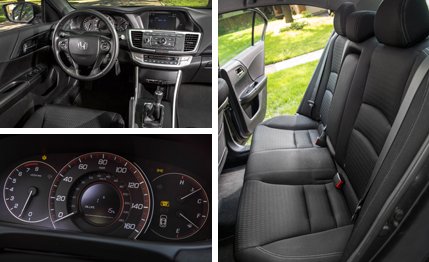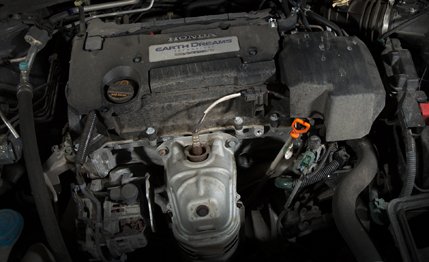 Long-Term Road Test Wrap-Up
Long-Term Road Test Wrap-Up
The Accord is nothing if not popular; Honda’s bestseller ranked second among all cars in the U.S. in 2013, with 366,678 sales. Unit number 58,634 entered the Car and Driver fleet shortly after this ninth generation made its debut and just after the Accord landed on our 10Best list for the 27th time. We have feted each generation since the second; we failed to recognize the first gen, not out of any editorial malfeasance, but because we didn’t establish our annual awards until 1983, after the ur-Accord was already out of production.
Do you know who really loves the Honda Accord, though? Thieves. The Accord tops recent surveys of the most-stolen vehicles by both the National Insurance Crime Bureau as well as security vendor LoJack. While that bellwether of desirability won’t be touted in Honda’s marketing, our long-termer’s as-tested price of just $24,180 qualifies as a steal. Or perhaps we just drove it like one.
“It’s hard to buy much car in this price range,” opined senior editor Jared Gall, “unless you buy this, which is the perfect car for just about everybody.”

Our idea of perfection was a sedan in the new Sport trim with a six-speed manual transmission. Having selected this model, we were absolved of making further choices since Honda restricts most options on the Sport to dealer-installed equipment. All Sport models are powered by Honda’s direct-injected 2.4-liter four. And while a continuously variable automatic is optional, we avoided it, fearing it would make us swell up like a nut-allergic kid touring the Skippy plant. The only other decision to make was color, or perhaps we should say shade, because Honda’s Ohio paint booth will only spray manual Sports in black or gray. We chose the latter to offset the dour black-cloth interior. And that was it. We imagine the Accord Sport to be a favorite of the clinically indecisive.
It would soon become a favorite of ours. Honda chopped 3.5 inches of length and 0.9 inch of wheelbase from the last-generation Accord, yet the large-car interior remains, earning praise for its roominess, comfort, and ergonomics. “Why can’t all sedans be this pleasant to live with?” asked executive editor Aaron Robinson. The tasteful new exterior styling was met with relief, if not exactly unanimous admiration. We would no longer need to explain, however, as in the eighth-gen era, how the Accord’s dynamics compensate for a dowdy appearance.
Our 10Best evaluation found that Honda’s move from control arms to a strut suspension in front had not diminished the Accord’s standing as an enthusiast-grade appliance. We described the Accord’s man-machine interface as “one big fluid loop,” a sentiment that would be reflected in comments throughout our long-term test. It was a car that would round off the frustrating edges of a commute—a low-heart-rate kind of sedan in traffic but an athlete on entrance ramps. Its chassis is so stable, its steering so responsive that it encourages the kind of hard driving that would ultimately lead to three separate trips to the dealer’s lathe for brake resurfacing.
 Honda was going to call this the "Fifty Shades of Grey" Accord, but licensing could not be obtained, hence the Sport moniker.
Honda was going to call this the "Fifty Shades of Grey" Accord, but licensing could not be obtained, hence the Sport moniker.
The front rotors succumbed to the cutter at two scheduled service appointments, plus a third trip solely to address the return of the vibrating middle pedal. Our dealer turned the rears once. Honda’s 36,000-mile warranty covered the first two events, but the third time, at just more than 37,000 miles, cost us $158. Despite these issues, our Accord still had enough metal left after 40,000 miles that its 70-mph stopping distance shrank a bit from 175 feet to 173.
The Accord’s four-cylinder felt more powerful on the street than would be indicated by its on-paper 189 horsepower, four stronger than in a standard four-cylinder Accord thanks to the dual exhaust fitted to Sport models [see the accompanying chassis dyno plot in specs]. Accentuating its smoothness is one of the best-shifting manuals extant. The crisp throttle response of the naturally aspirated engine stands in contrast to laggy turbocharged fours that have become common of late. Our Accord delivered the same 6.6-second zero-to-60-mph times at the beginning and end of its 40,000-mile test. No logbook commenter registered regret about passing up the V-6 model.
Accord Sport models wear 18-inch aluminum wheels and a pair of chrome exhaust tips as standard equipment, plus fog lamps and a spoiler. We liked the look of the wheels, though when we dinged one this spring, replacing it made us $451 poorer (plus $28 labor for remounting the tire). One of those fog lamps broke but was fixed under warranty. Leather, navigation, satellite radio, and heated seats are not available on Sports, and we missed them. As with nicotine, alcohol, and autoerotic asphyxiation, it always proves easier to proclaim this sort of stuff unnecessary than to actually go without.
Halfway through our test we noticed an intermittent whine coming from the front of the car, one unrelated to the lack of seat heaters. We mentioned it at the 30,000-mile service, but the dealer was not able to identify its source and an additional 10,000 miles did nothing to reveal its origin. Combined service charges for oil changes, filters, and inspections cost us $61 at 10,000 miles, $143 at 20,000 miles, and $152 at 30,000 miles, bringing the Accord’s total maintenance and repair bill to $1219. This is not unreasonable considering that the car returned an impressive 29 mpg while in our hands.

“A person with BMW dreams but a Walmart budget could buy this car and never be ashamed of his station in life. It’s that good,” read one logbook entry. Yet for all the praise heaped upon our Accord, we often overlooked it as commonplace, leaving its keys to languish on our sign-out board whenever sexier stuff rolled through. Yes, we drove the Accord to California to let our West Coast editors have a go, but it did not engender the kind of wanderlust or pride commensurate with our esteem.
But that may be part of this machine’s appeal. “The Accord’s greatness has always derived from its ability to disappear under its driver,” we wrote in our 10Best analysis. That it also acts as a vanishing cloak for roadway stress, only to reliably reemerge from the ether when called upon, makes the Accord one of the smartest choices on the market. Just be sure to keep your garage locked, lest it truly disappear. —Jeff Sabatini
Aaron Robinson: Ergonomics are old-school perfect, before mid-size car interiors were reshaped into interstellar attack ships.
Tony Quiroga: The slick shifter makes the manual version a must. I guess the CVT alternative does, too.
Alex Stoklosa: This is a fun, roomy, efficient sedan that I’d actually consider buying.
Mike Sutton: I’m still confused as to why you can’t get navigation with the manual, or a color other than gray or black.
Susanne Kocsis: Enjoyable simplicity—basic but not boring.
Eddie Alterman: This ninth-generation Accord represents a return to form—the major controls function with harmony and elegance; it’s huge inside and merely mid-size outside; its relatively low cowl and big side glass give its driver an intimate relationship with the road. This is the stuff that made the Accord so great in the first place.
David Beard: Plenty of nuts to cruise at 85 mph with ease.
Jared Gall: Find four adults who can’t fit comfortably inside, and, statistically speaking, one of them will be an NBA center.
Don Sherman: The peak power we measured at the front wheels is within 10 horsepower of Honda’s flywheel rating. Either Honda is being modest or it’s whittled driveline losses down to the nubs.